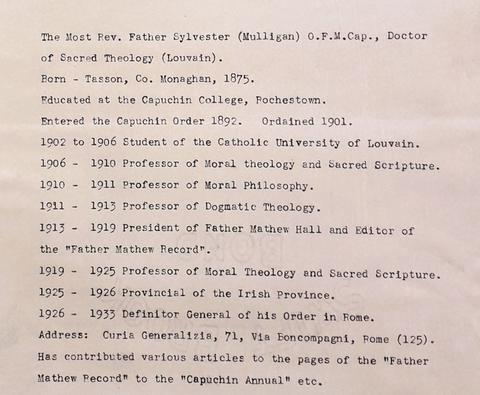Área de identidad
Código de referencia
Título
Fecha(s)
- c.1935 (Creación)
Nivel de descripción
Volumen y soporte
1 p.; typescript
Área de contexto
Nombre del productor
Historia biográfica
Patrick Mulligan, the son of John Mulligan and Brigid Mulligan (née Brennan), was born in County Monaghan on 12 March 1875. His family had a long association with the Capuchin Franciscan Order as five of his maternal uncles were among the first to join the Capuchins after the return of the friars to England in 1850. Following the completion of his preliminary studies at the Seraphic College in Rochestown, County Cork, Patrick Mulligan was received into the Capuchin Order on 30 March 1892. Upon joining the Order, he took Sylvester as his religious name. He was ordained a priest in Dublin on 21 September 1901. He was one of the first friars of the Irish Capuchin Province to pursue a course a higher course in theology in a continental university. Soon after his ordination, he enrolled in the Catholic University of Louvain in Belgium where he was awarded a degree of Doctor of Divinity (‘Doctor Divinitatis’). On his return to Ireland, he was appointed a lector in sacred theology in Rochestown. In 1913 he was appointed director of the Total Abstinence sodality on Church Street in Dublin and President of Father Mathew Hall. He also assumed the editorship of ‘The Father Mathew Record’ periodical. In 1919 he resumed his role as professor of theology in Rochestown. Fr. Sylvester held several senior administrative positions in the Irish Capuchin Province. He was first elected Definitor at the chapter held in 1907 and was re-elected to this position at subsequent chapters. In 1925 he was elected Provincial Minister. The following year he attended the General Chapter of the Capuchin Order in Rome and was elected Definitor General, the first member of the Irish Province to hold such office. He was re-elected at the next General Chapter held in 1932. On 13 April 1937 he was appointed Archbishop of Delhi and Simla in India, receiving his episcopal consecration (23 May 1937) from Cardinal Pietro Fumasoni Biondi, assisted by Patriarch Luca Ermenegildo Pasetto OFM Cap., and Bishop Giovanni Giuseppe Santini OFM Cap. At the time, there was only one Catholic priest in Delhi and the newly appointed Archbishop was forced to reside in a house attached to a school located on the grounds of the Cathedral of St. Michael and St. Joseph. Despite the disruption caused by the Second World War, Archbishop Mulligan worked assiduously in a challenging missionary environment. After being taken seriously ill during a Holy Year pilgrimage to Rome in June 1950, he returned to Ireland and underwent an operation in Dublin. Continuing ill-health forced his resignation as Archbishop on 12 August 1950. He died in Dublin on 23 October 1950. He was buried in Glasnevin Cemetery.
Baptismal name: Patrick Mulligan
Religious name: Fr. Sylvester Mulligan OFM Cap.
Date of birth: 12 Mar. 1875
Place of birth: Tasson, Clontibret, County Monaghan (Diocese of Clogher)
Name of father: John Mulligan
Name of mother: Brigid Mulligan (née Brennan)
Date of reception into the Capuchin Order: 30 Mar. 1892
Date of first profession: 2 Apr. 1893
Date of final profession: 25 Dec. 1897
Date of ordination (as priest): 21 Sept. 1901
Educational attainments: Licentiate of Sacred Theology (STL), Louvain; Doctor of Divinity (DD), Louvain
Missionary activities/Leadership positions: Provincial Definitor: 1907-10, 1916-9, 1922-5; Provincial Minister, 1925; Definitor General, 1926-9, 1932-7; Consecrated Archbishop of Delhi and Simla (India) on 23 May 1937. Resigned on 12 Aug. 1950.
Date of death: 23 Oct. 1950
Place of death: Dublin
Place of burial: Glasnevin Cemetery, Dublin
Institución archivística
Historia archivística
Origen del ingreso o transferencia
Área de contenido y estructura
Alcance y contenido
A biographical note on Fr. Sylvester Mulligan OFM Cap.

